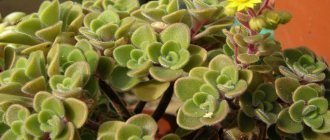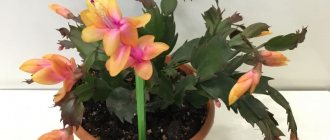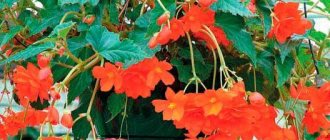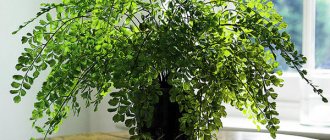Adiantum migrated to us from the tropics. There are several varieties of such ferns, but Venus hair is usually grown at home. It received this strange name because of its resemblance to women's hair. The plant can be found not only in Asia or Africa, but also in the North Caucasus, as well as in the mountainous part of Crimea, in the Far East. It thrives in indoor and greenhouse conditions and is able to withstand heat from radiators and even a drop in air temperature to critical values.
It usually grows up to 40-50 cm in height, has no smell and never blooms. The leaves are able to repel water, for which they received an additional name - “waterproof”. In the wild, it likes to settle on rocks near bodies of water.
Humidity and temperature
Venus hair does not like heat. +16-21C will suit him. Constantly ventilate the room with maidenhair, but keep in mind that you cannot keep a waterproof ward in drafts.
In winter it should be cooler and no heating devices nearby. Air humidity should be maintained high. For this purpose, spray the leaves at any time of the year.
Use in folk medicine
The benefits of adiantum were described in ancient times. Scientists of that time had a theory about the treatment of hair loss in people . And even today, in certain regions of Transcaucasia, adiantum is used in herbal collections as a means of activating hair growth.
In the modern world, the adiantum flower has been included in the list of various medicinal preparations due to official confirmation of its beneficial properties . It helps with the following problems:
- in the treatment of respiratory inflammation;
- for parasitic ;
- reduction in fever;
- to gently calm nervous symptoms.
When used correctly, the roots and green part of the stem help relieve symptoms of alcohol or chemical poisoning . In some countries, ointments were made from fresh leaves, ground to a homogeneous mass. They were applied to tumors. A decoction of the leaf part helps relieve pain in the stomach and intestines.
Feeding
You can use regular fertilizers, just halve the proportions compared to those indicated on the package. Fertilizers should not contain lime. Apply nutrients once every 20 days, from mid-spring to early autumn. Then take a break until next spring.
Watering
You need to know how to water a flower. The substrate must not be allowed to dry out, otherwise the fronds will begin to dry out. But under no circumstances should you overwater, otherwise the roots will rot.
The most convenient way is to immerse the flowerpot with your green friend in a bowl of water. Wait until the top layer of soil shines and put it in the sink to drain off the excess. After this, return to its normal place.
In winter, the intervals between waterings need to be doubled, but such baths should be carried out from time to time.
Landing rules
There are several rules, following which the barberry bush will decorate the garden plot for a very long time. First you need to decide on a location; it must meet the following requirements:
- It is necessary to have a large amount of sunlight; shading can cause changes in the color of the leaves;
- although barberry loves moisture, its excess can destroy the plant, so you should avoid lowlands and places where precipitation and melted snow accumulate;
- Also, barberry should not be planted in places with high groundwater levels.
The gardener must take into account the diameter of the crown of the bush and place it at a distance of at least 4 meters from other plantings.
It is also necessary to prepare the soil in advance. If planting is carried out in the spring, then the soil is prepared in the fall, and in the case of autumn planting 3-4 weeks before work:
- High acidity is not allowed, therefore, if this indicator is present, it is necessary to add lime or dolomite flour;
- Loamy or chernozem soil needs to be “lightened” with peat or sand;
- The size of the hole depends on the age of the plant:
- up to 2 years, the diameter and depth are 25-30 centimeters;
- for shrubs under 3 years of age, the pit dimensions will be 50x50 centimeters.
If barberry is planted as a hedge, it is necessary to dig a trench with a width and depth of 40 centimeters.
- When digging a hole, the top fertile layer of soil is mixed with:
- 2 buckets of compost or humus;
- 2 buckets of sand;
- 100 grams of superphosphate.
The best time for planting is considered to be early spring, but work can also be done in mid-October.
Before planting, the soil must be thoroughly moistened and additionally watered after the seedling is in the ground. It is also recommended to mulch the soil.
Adiantum transplant
Growing at home also involves Venus hair transplantation. You need to keep your pet in a cramped pot and resort to transferring it to a new pot only when the roots become visible in the drainage holes. The procedure is carried out exclusively in the spring.
For a young fern, the interval between transplants should be 2-3 years. You don’t have to touch the old one, just replace the top layer of soil mixture with a new one. The flowerpot should be only 2 cm wider in diameter than the old one.
After removing it from the old pot, transfer the plant to a new one without shaking off the old soil. Plant in a mixture of peat and rotted leaves in a 2:1 ratio. Before planting, be sure to line the bottom of the container with a layer of expanded clay for drainage.
Reproduction methods
Adiantum can be propagated by two methods:
- dividing the bush;
- sowing spores.
The last method is too complicated, so it is not advisable for novice gardeners to use it.
Dividing the bush
The procedure is carried out in the spring during transplantation. Having pulled the bush out of the pot, it is divided into several parts manually or using a knife. Each part should have a piece of root and a leaf with a bud. The cut areas should be sprinkled with activated carbon and then kept in the root. After this, plant each part in a separate pot, leaving the root collar outside.
It is advisable to arrange a mini-greenhouse for the seedlings to keep them warm and humid. Be patient - Venus hair will not grow right away. This will take some time.
Growing with spores
Seeds should be collected from the bottom of the leaf blades. It is advisable to take the largest ones. Soak them in a solution of potassium permanganate and let them dry for another 2 weeks. Then you can plant it in soil mixture poured into a shallow box. Scatter the spores over the surface and cover with glass on top.
First, place the container in a dark but warm place. In the middle of the day, remove the glass for ventilation. As soon as the first shoots appear, remove the glass and move the container closer to the window, but do not place it on the windowsill itself.
Sprouts that have reached 2-3 cm, dive into another box, planting them at a greater distance. It can be transplanted to a permanent place when the adiantums reach 7 cm.
Description
Adiantum (adianthum) is a perennial fern-like plant of the Pteris family, which includes about 200 species.
Most ferns are native to South America and East Asia. In the tropical and subtropical climate of these hemispheres, plants thrive and develop independently. In the nature of our country, there are two types of adiantum - Adiantum capillus veneris (Venus hair) and Adiantum pedatum (foot-shaped adiantum). The common features of all types of adiantums are:
- thin creeping roots;
- short stature (does not exceed 60 cm);
- dissected drooping leaves (fronds) located on dark shiny petioles;
- spores found on the underside of leaf blades.
An interesting feature of maidenhair leaves is that they do not absorb water, but repel it. When water hits the leaves, the drops immediately flow off without wetting their surface. The main difference between the different types is the size, shape of the cut of the leaf plates and their color. Depending on the variety, they can be from 5 to 50 cm in length, and the color range varies from light green to red-brown. Due to the beauty and grace of its leaves, the flower has become very popular among breeders, and new decorative forms have been obtained.
Some varieties join the ranks of indoor plants, while others decorate garden plots.
Briefly about the history of appearance
The flower first settled in houses back in the 19th century. Cultivation and propagation took place on the estates of the rich, who had greenhouses and winter gardens. Over time, the plant began to appear among ordinary people.
Note! The name “adiantum” originates in Greece and translated into Russian means “not to wet.” There is an invisible film on the surface of the leaves, thanks to which water is not absorbed into the structure, but drains.
Medicinal properties
The indoor flower has antipyretic, antiparasitic and soothing properties. The plant relieves inflammation well. The leaves contain steroids, essential oils and phenolcarboxylic acids.
Diseases and pests
By the appearance of Venus's hair, one can judge the problems that have arisen with the pet.
Pests
As soon as you notice the harmful activity of spider mites or aphids, take immediate action. You need to remove the cobwebs, remove discolored fronds, and give your green friend a bath using laundry soap. To be sure, you should also use insecticides.
Scale insects should be combated with a cotton swab dipped in alcohol.
Possible problems
Failure to follow the rules for caring for your pet indoors can lead to death, so you should adhere to all necessary measures.
Yellowing of leaves and dark stains
Appear when the temperature is too low.
Drying of the crown
May be caused by drafts or hot air flows coming from the batteries.
The fronds are wrinkled
Due to insufficient watering.
Pale leaves
Occurs due to excess sun or lack of nutrients.
Drying ends
This happens due to low air humidity in the room.
Rolling leaves
Indicates low temperature or too high air humidity.
Don't wait to see Adiantum flowers. Venus hair never blooms. It is bred solely for its decorative appearance. But if you put a flowerpot with this fern at home, you can count on happiness and love.
Basics of care
Caring for this fern is very simple, but there are some nuances to its maintenance.
Temperature
Adiantum really does not like hot air. In summer, the optimal temperature is no higher than +22. In winter, the fern should be in the room at +15. It is advisable to place the flowerpot away from heating appliances.
Location
Adiantum is a houseplant that does not tolerate direct sunlight at all. The flower prefers partial shade or light shade. Therefore, it is better to grow it on northern or eastern windowsills.
This flower really does not like rearrangements. You need to move the pot as little as possible. It is not recommended to constantly unwrap the pot.
It is important to know: if the plant is brightly illuminated by the sun, the light green lacy leaves will quickly fade and the flower will soon die.
Adiantum loves clean air very much, so the room needs to be ventilated as often as possible. The plant does not tolerate drafts and dust at all. Therefore, it is necessary to frequently do wet cleaning in the room where these flowers are located. It is not advisable to smoke in a room where maidenhair grows. You should not place a flowerpot with a flower in the kitchen, as kitchen fumes can lead to its death.
Humidity and irrigation regime
Indoor fern loves spraying. During hot periods, you can spray the plant even twice a day. But when the room is cool in winter, spraying the flower can harm it. Starting in the fall, with the first cold snap, spraying is stopped.
The fern should be watered regularly, avoiding allowing the soil in the pot to dry out. If the earthen ball dries out, the plant may even die. Conversely, constant waterlogging of the earthen clod can lead to the appearance of various rots.
To water the plant correctly, it is best to place the pot in a tray with water and hold it until the soil absorbs the moisture. The top layer of soil in the flowerpot should shine with water. After this, the flowerpot is taken out of the pallet.











